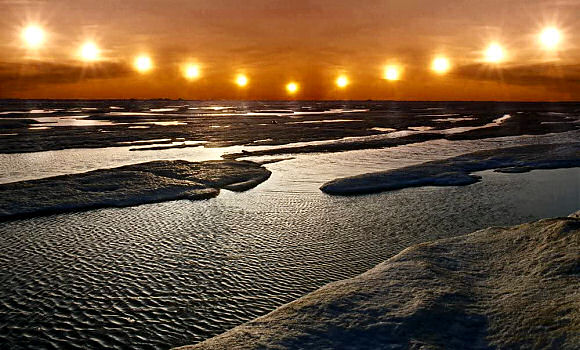
That wonderful time-lapse video was taken by astrophotographer
Göran Strand just a little more than a day ago. He was standing on a big sphere—
The midnight Sun never set’s.
[Compiled by Parikṣit dās]
North of the Arctic Circle, periods of constant sunshine last for up to six months of the year at the North Pole. The opposite is also true for parts of the year, though. Above the Arctic Circle, the sun never rises on the day of the winter solstice (usually around December 21).
The midnight sun is a natural phenomenon that occurs in the summer months in places north of the Arctic Circle or south of the Antarctic Circle, when the sun remains visible at the local midnight. When the midnight sun is seen in the Arctic, the sun appears to move from left to right, but in Antarctica the equivalent apparent motion is from right to left.
In the summer, the sun it never sets. It just circles the pole. Actually this is relatively easy to explain with a flat Earth. In the flat Earth model, the sun would never set anywhere; it would just bob up and down and circle around. It’s the setting part that doesn’t make any sense in a flat Earth model.
THE SUN DOES NEVER SET NOR RISE
In the Aitareya Brahmana of RigVeda 3.44
“The Sun does never set nor rise. When people think the Sun is setting (it is not so). For after having arrived at the end of the day it makes itself produce two opposite effects, making night to what is below and day to what is on the other side…Having reached the end of the night, it makes itself produce two opposite effects, making day to what is below and night to what is on the other side. In fact, the Sun never sets….”
Aitreya Brāhmaṇa 2.7 1kBCE or older
“The Sun never really sets or rises. In that they think of him “He is setting”, having reached the end of the day, he inverts himself; thus he makes evening below, day above. Again in that they think of him “He is rising in the morning”, having reached the end of the night he inverts himself; thus he makes day below, night above. He never sets; indeed he never sets.”
Regarding the rising and setting of Sun, Aitreya Brahmana of RigVeda 3.44 states: The Sun does never set nor rise. When people think the Sun is setting (it is not so). For after having arrived at the end of the day it makes itself produce two opposite effects, making night to what is below and day to what is on the other side…Having reached the end of the night, it makes itself produce two opposite effects, making day to what is below and night to what is on the other side. In fact, the Sun never sets….”
Yoga Vasistha also states: Vasishta said:— There is only one space enveloping all things. The worlds seen in the infinite and indiscernible womb of emptiness are like worms moving on the surface of water. All these bodies that move about in the world by their lack of freedom are thought to be up and down relative to our position on earth.
Similar verse also occurs in Śrīmad-Bhāgavatam 5.21.8-9:
tatratyānāṁ divasa-madhyaṅgata eva sadādityas tapati savyenācalaṁ dakṣiṇena karoti; yatrodeti tasya ha samāna-sūtra-nipāte nimlocati yatra kvacana syandenābhitapati tasya haiṣa samāna-sūtra-nipāte prasvāpayati tatra gataṁ na paśyanti ye taṁ samanupaśyeran.
People living in countries at points diametrically opposite to where the sun is first seen rising will see the sun setting, and if a straight line were drawn from a point where the sun is at midday, the people in countries at the opposite end of the line would be experiencing midnight. Similarly, if people residing where the sun is setting were to go to countries diametrically opposite, they would not see the sun in the same condition.
The living entities residing on Sumeru Mountain are always very warm, as at midday, because for them the sun is always overhead. Although the sun moves counterclockwise, facing the constellations, with Sumeru Mountain on its left, it also moves clockwise and appears to have the mountain on its right because it is influenced by the dakṣiṇāvarta wind.
na vai mahārāja bhagavato māyā-guṇa-vibhūteḥ kāṣṭhāṁ manasā vacasā vādhigantum alaṁ vibudhāyuṣāpi puruṣas tasmāt prādhān-yenaiva bhū-golaka-viśeṣaṁ nāma-rūpa-māna-lakṣaṇato vyākhyāsyāmaḥ.
The great ṛṣi Śukadeva Gosvāmī said: My dear King, there is no limit to the expansion of the Supreme Personality of Godhead’s material energy. This material world is a transformation of the material qualities [sattva-guṇa, rajo-guṇa and tamo-guṇa], yet no one could possibly explain it perfectly, even in a lifetime as long as that of Brahmā No one in the material world is perfect, and an imperfect person could not describe this material universe accurately, even after continued speculation. O King, I shall nevertheless try to explain to you the principal regions, such as Bhū-goloka [Bhūloka], with their names, forms, measurements and various symptoms. (Śrīmad-Bhāgavatam 5.16.4)
mūrdhany arpitam aṇuvat sahasra-mūrdhno
bhū-golaṁ sagiri-sarit-samudra-sattvam
ānantyād animita-vikramasya bhūmnaḥ
ko vīryāṇy adhi gaṇayet sahasra-jihvaḥ
Because the Lord is unlimited, no one can estimate His power. This entire universe, filled with its many great mountains, rivers, oceans, trees and living entities, is resting just like an atom on one of His many thousands of hoods. Is there anyone, even with thousands of tongues, who can describe His glories? (Śrīmad-Bhāgavatam 5.25.12)
THE MOVEMENTS OF THE SUN
[Śrīmad-Bhāgavatam Canto 5, Chapter 25]
The sun is not stationary; it is also moving like the other planets. The sun’s movements determine the duration of night and day. When the sun travels north of the equator, it moves slowly during the day and very quickly at night, thus increasing the duration of the daytime and decreasing the duration of night. Similarly, when the sun travels south of the equator, the exact opposite is true—the duration of the day decreases, and the duration of night increases. When the sun enters Karkaṭa-rāśi (Cancer) and then travels to Siṁha-rāśi (Leo) and so on through Dhanuḥ-rāśi (Sagittarius), its course is called Dakṣiṇāyana, the southern way, and when the sun enters Makara-rāśi (Capricorn) and thereafter travels through Kumbharāśi (Aquarius) and so on through Mithuna-rāśi (Gemini), its course is called Uttarāyaṇa, the northern way. When the sun is in Meṣa-rāśi (Aries) and Tulā-rāśi (Libra), the duration of day and night are equal.
On Mānasottara Mountain are the abodes of four demigods. East of Sumeru Mountain is Devadhānī, where King Indra lives, and south of Sumeru is Saṁyamanī, the abode of Yamarāja, the superintendent of death. Similarly, west of Sumeru is Nimlocanī, the abode of Varuṇa, the demigod who controls the water, and north of Sumeru is Vibhāvarī, where the demigod of the moon lives. Sunrise, noon, sunset and midnight occur in all these places because of the movements of the sun. Diametrically opposite the place where the sunrise takes places and the sun is seen by human eyes, the sun will be setting and passing away from human vision. Similarly, the people residing diametrically opposite the point where it is midday will be experiencing midnight. The sun rises and sets with all the other planets, headed by the moon and other luminaries.
The entire kāla-cakra, or wheel of time, is established on the wheel of the sun-god’s chariot. This wheel is known as Saṁvatsara. The seven horses pulling the chariot of the sun are known as Gāyatrī, Bṛhatī, Uṣṇik, Jagatī, Triṣṭup, Anuṣṭup and Paṅkti. They are harnessed by a demigod known as Aruṇadeva to a yoke 900,000 yojanas wide. Thus the chariot carries Ādityadeva, the sun-god. Always staying in front of the sun-god and offering their prayers are sixty thousand sages known as Vālikhilyas. There are fourteen Gandharvas, Apsarās and other demigods, who are divided into seven parties and who perform ritualistic activities every month to worship the Supersoul through the sun-god according to different names. Thus the sun-god travels through the universe for a distance of 95,100,000 yojanas (760,800,000 miles) at a speed of 16,004 miles at every moment.

THE SUN TRAVELS OVER ALL SIDES OF
MĀNASOTTARA MOUNTAIN IN A CIRCLE
Śukadeva Gosvāmī continued; My dear King, as stated before, the learned say that the sun travels over all sides of Mānasottara Mountain in a circle whose length is 95,100,000 yojanas [760,800,000 miles]. On Mānasottara Mountain, due east of Mount Sumeru, is a place known as Devadhānī, possessed by King Indra. Similarly, in the south is a place known as Saṁyamanī, possessed by Yamarāja, in the west is a place known as Nimlocanī, possessed by Varuṇa, and in the north is a place named Vibhāvarī, possessed by the moon-god. Sunrise, midday, sunset and midnight occur in all those places according to specific times, thus engaging all living entities in their various occupational duties and also making them cease such duties.
From the residence of Yamarāja the sun travels to Nimlocanī, the residence of Varuṇa, from there to Vibhāvarī, the residence of the moon-god, and from there again to the residence of Indra. In a similar way, the moon, along with the other stars and planets, becomes visible in the celestial sphere and then sets and again becomes invisible.
Thus the chariot of the sun-god, which is trayīmaya, or worshiped by the words oṁ bhūr bhuvaḥ svaḥ, travels through the four residences mentioned above at a speed of 3,400,800 yojanas [27,206,400 miles] in a muhūrta.
The chariot of the sun-god has only one wheel, which is known as Saṁvatsara. The twelve months are calculated to be its twelve spokes, the six seasons are the sections of its rim, and the three cātur-māsya periods are its three-sectioned hub. One side of the axle carrying the wheel rests upon the summit of Mount Sumeru, and the other rests upon Mānasottara Mountain. Affixed to the outer end of the axle, the wheel continuously rotates on Mānasottara Mountain like the wheel of an oil-pressing machine. (SB/5/21/13)
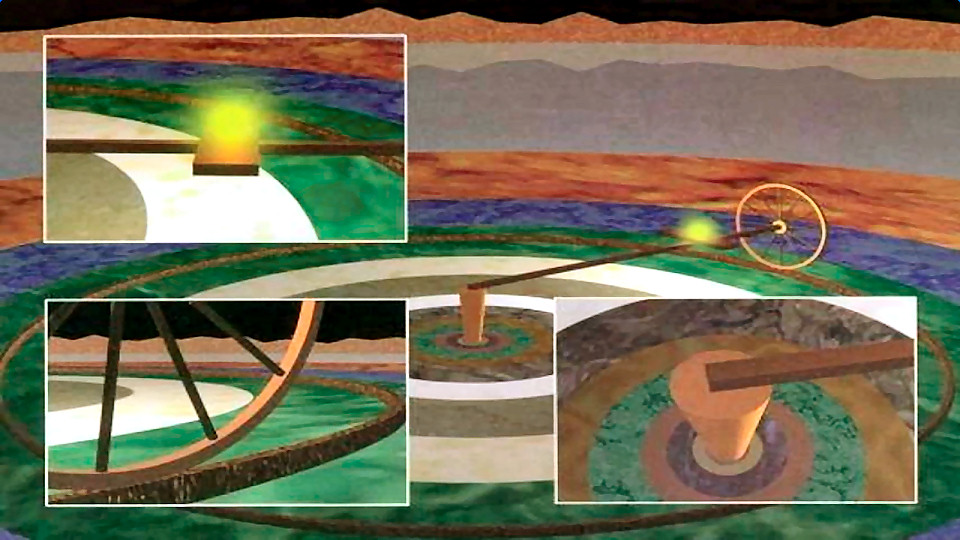
Affixed to the outer end of the axle, the wheel continuously rotates
on Mānasottara Mountain like the wheel of an oil-pressing machine
As in an oil-pressing machine, this first axle is attached to a second axle, which is one-fourth as long [3,937,500 yojanas, or 31,500,000 miles]. The upper end of this second axle is attached to Dhruvaloka by a rope of wind. Like bulls yoked to a central pivot, all the planetary systems revolve around Dhruvaloka, impelled by eternal time. [SB/5/21/14]
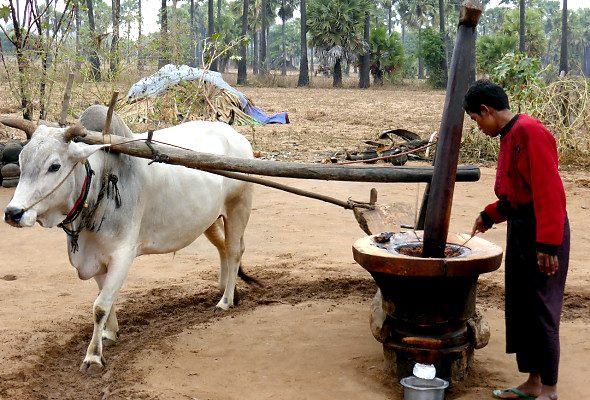
My dear King, the carriage of the sun-god’s chariot is estimated to be 3,600,000 yojanas [28,800,000 miles] long and one-fourth as wide [900,000 yojanas, or 7,200,000 miles]. The chariot’s horses, which are named after Gāyatrī and other Vedic meters, are harnessed by Aruṇadeva to a yoke that is also 900,000 yojanas wide. This chariot continuously carries the sun-god.
The seven horses yoked to the sun-god’s chariot are named Gāyatrī, Bṛhati, Uṣṇik, Jagatī, Triṣṭup, Anuṣṭup and Paṅkti. These names of various Vedic meters designate the seven horses that carry the sun-god’s chariot. (SB/5/21/15)
THE SUN IS SITUATED IN OUTER SPACE BETWEEN
THE UPPER AND LOWER PORTIONS OF THE UNIVERSE.
The sun-god, who is Nārāyaṇa, or Viṣṇu, the soul of all the worlds, is situated in outer space between the upper and lower portions of the universe. Passing through twelve months on the wheel of time, the sun comes in touch with twelve different signs of the zodiac and assumes twelve different names according to those signs. The aggregate of those twelve months is called a saṁvatsara, or an entire year. According to lunar calculations, two fortnights—one of the waxing moon and the other of the waning—form one month. That same period is one day and night for the planet Pitṛloka. According to stellar calculations, a month equals two and one quarter constellations. When the sun travels for two months, a season passes, and therefore the seasonal changes are considered parts of the body of the year.
Thus the time the sun takes to rotate through half of outer space is called an ayana, or its period of movement [in the north or in the south].
THE SPEED OF THE SUN-GOD’S CHARIOT
My dear King, in his orbit through Bhū-maṇḍala, the sun-god traverses a distance of 95,100,000 yojanas [760,800,000 miles] at the speed of 2,000 yojanas and two krośas [16,004 miles] in a moment.
The sun-god has three speeds—slow, fast and moderate. The time he takes to travel entirely around the spheres of heaven, earth and space at these three speeds is referred to, by learned scholars, by the five names Saṁvatsara, Parivatsara, Iḍāvatsara, Anuvatsara and Vatsara.
PURPORT: According to solar astronomical calculations, each year extends six days beyond the calendar year, and according to lunar calculations, each year is six days shorter. Therefore, because of the movements of the sun and moon, there is a difference of twelve days between the solar and lunar years. As the Saṁvatsara, Parivatsara, Iḍāvatsara, Anuvatsara and Vatsara pass by, two extra months are added within each five years. This makes a sixth saṁvatsara, but because that saṁvatsara is extra, the solar system is calculated according to the above five names.
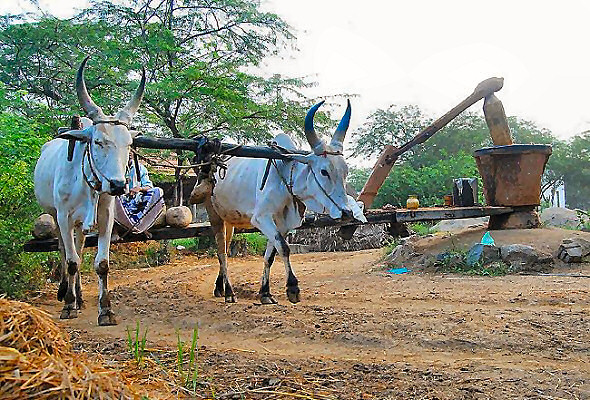
When bulls are yoked together and tied to a central post to thresh rice, they tread around that pivot without deviating from their proper positions—one bull being closest to the post, another in the middle, and a third on the outside. Similarly, all the planets and all the hundreds and thousands of stars revolve around the polestar, the planet of Mahārāja Dhruva, in their respective orbits, some higher and some lower. Fastened by the Supreme Personality of Godhead to the machine of material nature according to the results of their fruitive acts, they are driven around the polestar by the wind and will continue to be so until the end of creation. These planets float in the air within the vast sky, just as clouds with hundreds of tons of water float in the air or as the great śyena eagles, due to the results of past activities, fly high in the sky and have no chance of falling to the ground.
SUN GOES ROUND AND ROUND IN A CIRCLE
Matsya Purana 126.41-46 “The Sun in course of one single day and night goes swiftly over the world consisting of the seven oceans and the seven islands, seating in His one-wheeled chariot and drawn by seven horses. The seven horses yoked to the Sun’s chariot are no other than the seven chhandas metres); they can assume forms at their will; they go as they like…Ascending on such a chariot the Sun travels the earth in course of one day (24 hours).
The horses were yoked at the beginning of Kalpa and carry on the Sun till the end of the Great Dissolution (Maha Pralaya). Thus He goes on round and round, day and night, surrounded by the Valakhillya Munis…” Tr. Taluqdar of Oudh, Edited by B.D. Basu
Brahmanda Purana 1.2.21.87-88 “Everyday the sun traverses those (zones) in due order. Just as the outer rim of the potter’s wheel comes back quickly (i.e. revolves), so also the sun functions quickly during his Souther transit. Hence, he traverses a major portion of the Earth in the course of a shorter period.” Tr. G.V. Tagare
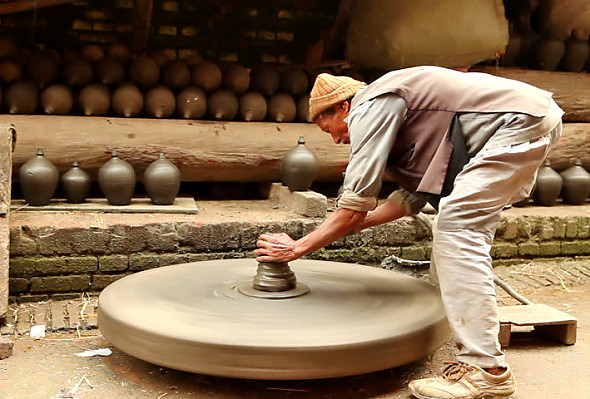
Śrīmad-Bhāgavatam: My dear lord, you have already affirmed the truth that the supremely powerful sun-god travels around Dhruvaloka with both Dhruvaloka and Mount Sumeru on his right. Yet at the same time the sun-god faces the signs of the zodiac and keeps Sumeru and Dhruvaloka on his left. How can we reasonably accept that the sun-god proceeds with Sumeru and Dhruvaloka on both his left and right simultaneously?
Śrī Śukadeva Gosvāmī clearly answered: When a potter’s wheel is moving and small ants located on that big wheel are moving with it, one can see that their motion is different from that of the wheel because they appear sometimes on one part of the wheel and sometimes on another. Similarly, the signs and constellations, with Sumeru and Dhruvaloka on their right, move with the wheel of time, and the antlike sun and other planets move with them. The sun and planets, however, are seen in different signs and constellations at different times. This indicates that their motion is different from that of the zodiac and the wheel of time itself. (SB 5.22.2)
When the moon is waxing, the illuminating portions of it increase daily, thus creating day for the demigods and night for the pitas. When the moon is waning, however, it causes night for the demigods and day for the pitas. In this way the moon passes through each constellation of stars in thirty muhurtas [an entire day]. The moon is the source of nectarean coolness that influences the growth of food grains, and therefore the moon-god is considered the life of all living entities. He is consequently called Jiva, the chief living being within the universe. (SB 5.22.9)
The moon is situated 100,000 yojanas above the rays of the sunshine. Day and night on the heavenly planets and Pitrloka are calculated according to its waning and waxing. Above the moon by a distance of 200,000 yojanas are many stars, and above these stars is Sukra-graha (Venus), whose influence is always auspicious for the inhabitants of the entire universe. Above Sukra-graha by 200,000 yojanas is Budha-graha (Mercury), whose influence is sometimes auspicious and sometimes inauspicious. Next, above Budha-graha by 200,000 yojanas, is Angaraka (Mars), which almost always has an unfavorable influence. Above Angaraka by another 200,000 yojanas is the planet called Brhaspati-graha (Jupiter), which is always very favorable for qualified brahmanas. Above Brhaspati-graha is the planet Sanaiscara (Saturn), which is very inauspicious, and above Saturn is a group of seven stars occupied by great saintly persons who are always thinking of the welfare of the entire universe. These seven stars circumambulate Dhruvaloka, which is the residence of Lord Visnu within this universe.
Situated 1,100,000 yojanas above Saturn, or 2,600,000 yojanas above earth, are the seven saintly sages, who are always thinking of the well-being of the inhabitants of the universe. They circumambulate the supreme abode of Lord Visnu, known as Dhruvaloka, the polestar. (SB 5.22.17)

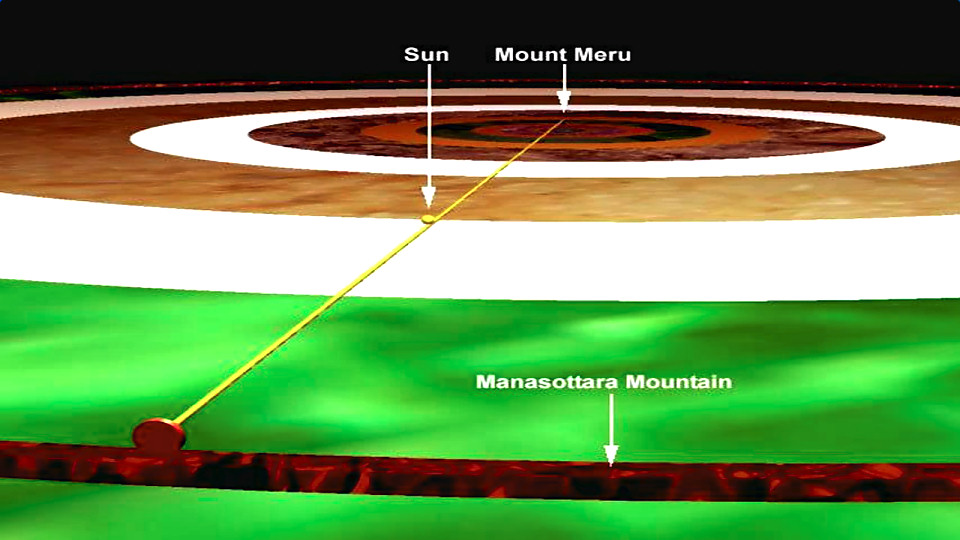









Pamho agtacbsp,surya-loka Narayana ki jai, the personality in the 8.400.000 form of species of life including the zodiac sign in animals humans and demigods is the job of Surya deva yasyajnaya bhramati sambhrita Kala chakro through the factor time surya deva and His sons shani deva and Yamaraj are very busy they work together to bring the crazy jiva tattva back to dharma a vaisnava offer Gayatri three times a day to get the blessings of such exalted devotees of the suryavamsa dynasty ki jai navagraha ki jai agtacbsp ys haribol